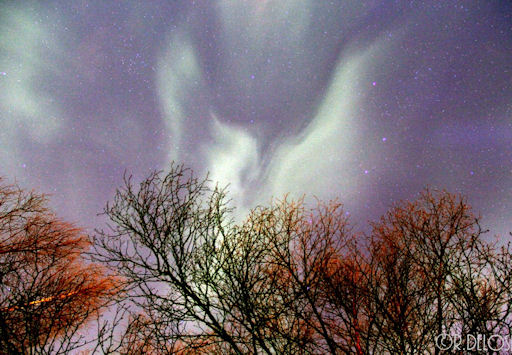CHANCE OF FLARES: Sunspot AR1465 has developed a 'beta-gamma-delta' magnetic field that harbors energy for X-class solar flares. Because of the sunspot's location near the middle of the solar disk, any eruptions will likely be Earth-directed. Solar flare alerts: text, phone.
QUIETING STORM, MORE TO COME: Earth's magnetic field is quieting after two straight nights of mild to moderate geomagnetic storms. At the height of the disturbance on April 23-24, auroras were spotted in more than a dozen US states including Michigan, Nebraska, Kansas, Wisconsin, North Dakota, South Dakota, Iowa, Illinois, Minnesota, and Colorado. On the threshold of the Arctic Circle in Anchorage, Alaska, the Northern Lights pierced the glow of the midnight sun:
"I didn't think I would get another glimpse of the auroras this season because of the increasing daylight," says photographer Ryan Delos Reyes, "but this was a spectacular show."
More auroras may be in the offing. A minor CME is en route to Earth, due to arrive on April 26th. NOAA forecasters estimate a 20% to 30% chance of geomagnetic storms. Aurora alerts: text, phone
![]()

![]()
Solar wind
speed: 668.1 km/sec
density: 0.1 protons/cm3
explanation | more data
Updated: Today at 1635 UT
![]()
X-ray Solar Flares
6-hr max: C3 1215 UT Apr25
24-hr: C3 1215 UT Apr25
explanation | more data
Updated: Today at: 1600 UT
![]()
![]()
![]()
Daily Sun: 25 Apr 12
![]()
![]()
Sunspot 1465 has developed a "beta-gamma-delta" magnetic field that harbors energy for X-class solar flares. Credit: SDO/HMI
![]()
![]()
![]()
Sunspot number: 169
What is the sunspot number?
Updated 23 Apr 2012
Spotless Days
Current Stretch: 0 days
2012 total: 0 days (0%)
2011 total: 2 days (<1%)
2010 total: 51 days (14%)
2009 total: 260 days (71%)
Since 2004: 821 days
Typical Solar Min: 486 days
Updated 23 Apr 2012
The Radio Sun
10.7 cm flux: 142 sfu
explanation | more data
Updated 23 Apr 2012
![]()
![]()
![]()
Current Auroral Oval:
Switch to: Europe, USA, New Zealand, Antarctica
Credit: NOAA/POES
![]()
![]()
![]()
Planetary K-index
Now: Kp= 2 quiet
24-hr max: Kp= 5 storm
explanation | more data
![]()
Interplanetary Mag. Field
Btotal: 7.5 nT
Bz: 4.1 nT south
explanation | more data
Updated: Today at 1636 UT
![]()
![]()
![]()
Coronal Holes: 24 Apr 12
![]()
![]()
There are no large coronal holes on the Earthside of the sun. Credit: SDO/AIA.





